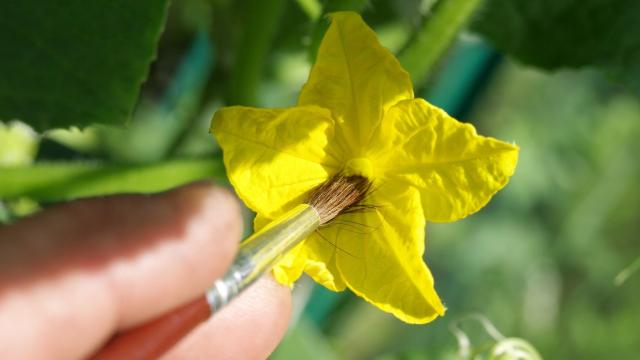Tickling your tomato blossoms and brushing your squash flowers probably aren’t regular tasks on your gardening to-do list, but it turns out that hand pollination, in league with natural processes, can actually increase your yield on lots of staple garden veggies.
With this simple trick, you can enjoy a more bountiful return on all the money and hard work you’ve invested in your veggie patch. Here are some methods to hand pollinate your crops that are easy for any gardener, no matter your experience level.
What you’ll need
For this project, you’ll need a small paint brush — no bigger than about a quarter inch — a cotton swab or a toothbrush, and some rubbing alcohol to clean your brush.
What kind of plants can be hand pollinated?
Many types of common garden plants can be pollinated by hand, including tomatoes, squash, pumpkins, cucumbers, beans, peppers, corn, and strawberries, just to name a few. If you can find the stamen and anthers in your plant’s flower, you can likely hand pollinate it.
The stamen is usually found in the centre of the flower, and looks like small tendrils with dusty, rounded tips (known as anthers) that produce pollen. Dropping the pollen from the stamen onto the stigma, a sticky surface on the inside of the cup of a flower is what causes successful pollination and allows a plant to grow fruit.
How to hand-pollinate self-pollinating plants
For self pollinating plants like tomatoes or peppers, use your brush to tickle the inside of the flower to dislodge some pollen so it falls onto the stigma, encouraging the female receptors in the flower to catch the male part of the DNA. Clean your brush and allow it to dry thoroughly before moving on to the next flower to avoid cross pollination–or live dangerously, and cross-pollinate your self-pollinating plants to encourage a little more variety and surprise in your garden.
How to hand-pollinate cross-pollinating plants
For cross pollinating plants like squash or cucumbers, you will need to be able to identify the male and female flowers on the plant in order to deliver the genetic information contained in the pollen to the female pollen receptors. Most of the time, male flowers will grow in groups while female flowers will appear individually. The telltale sign of the male flower is dusty pollen on the tips of the anthers. To access the pollen, you can strip away the petals and put your brush into the pollen, then gently touch the brush to the female flower. As if you were brushing paint, make sure to re-dip your brush into the pollen frequently to ensure even coverage.
Use a hormone spray for increased pollen drop
If you prefer a broader approach to hand pollinating, you can try what’s known as a blossom set-spray. This is a spray containing the naturally occurring hormone called cytokine that encourages plants to drop their pollen, which is what causes the flower to produce fruit.
Try a pheromone bee bait
If you want to attract more natural pollinators without getting directly involved in the process, use a bee bait that will signal to honey bees that there’s good nectar on offer in your garden. Using a pheromone based spray to attract more natural pollinators can be a way to overcome a lack of pollination in your garden. This will also increase your yields over time, and help out your local population of bees and butterflies in search of a food source.

Leave a Reply
You must be logged in to post a comment.